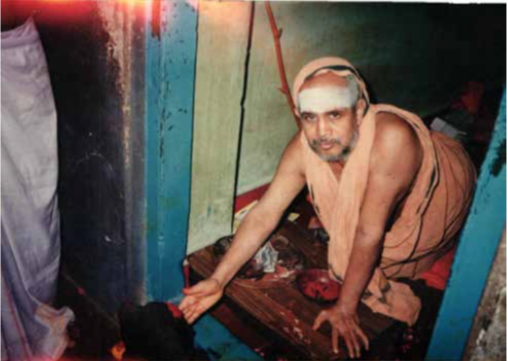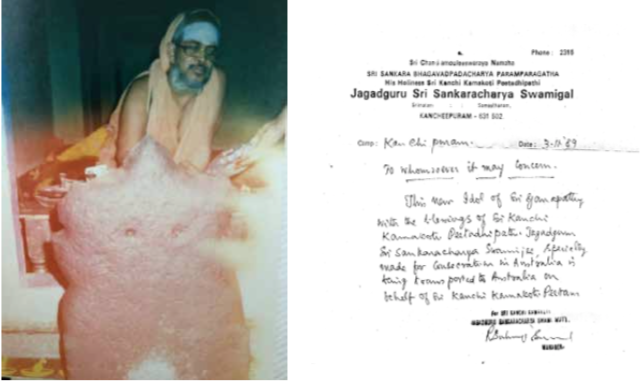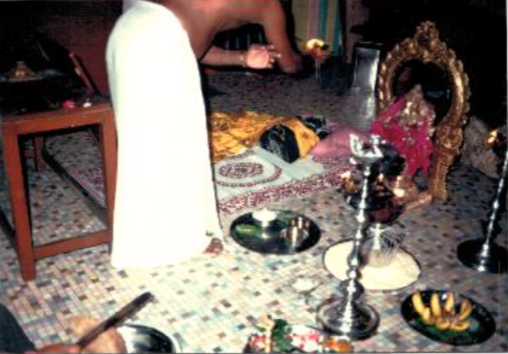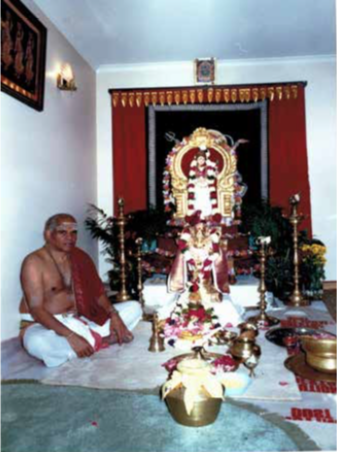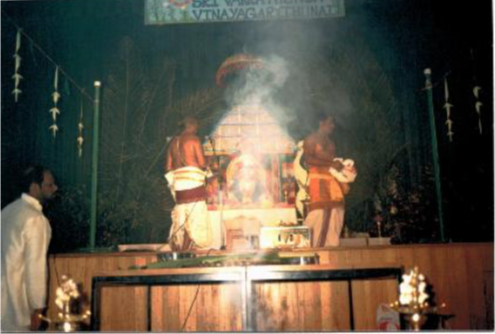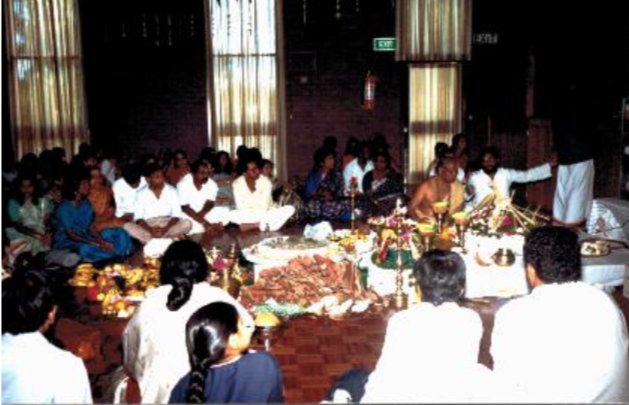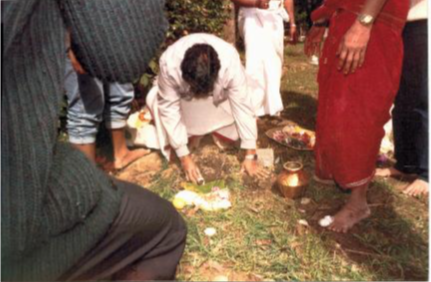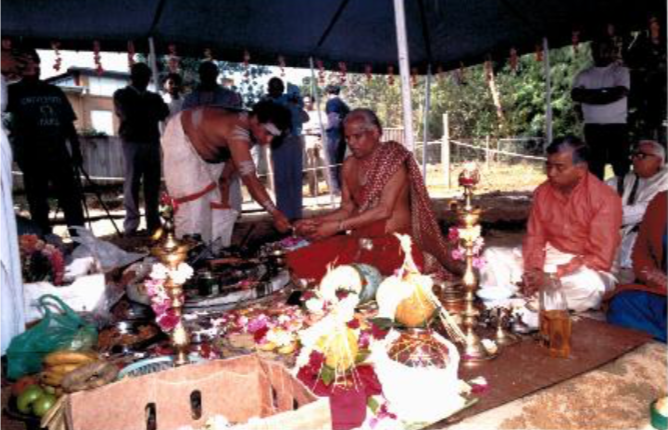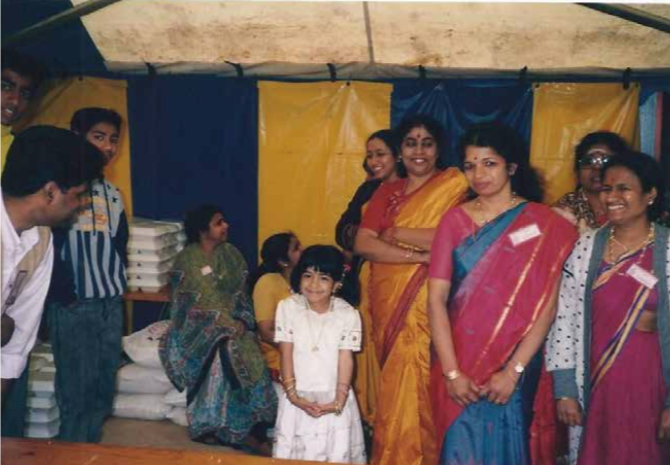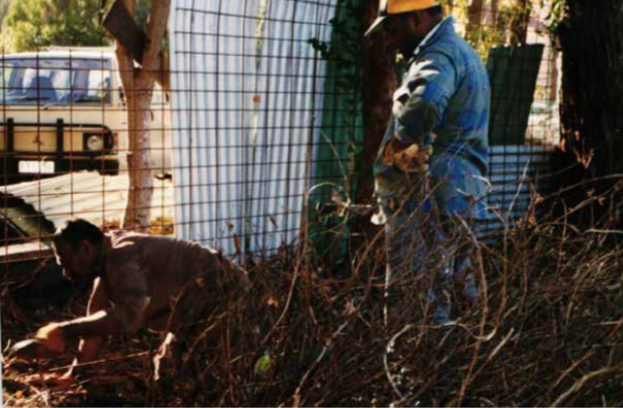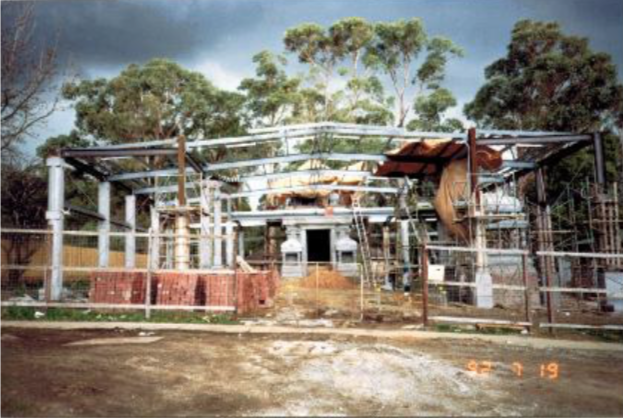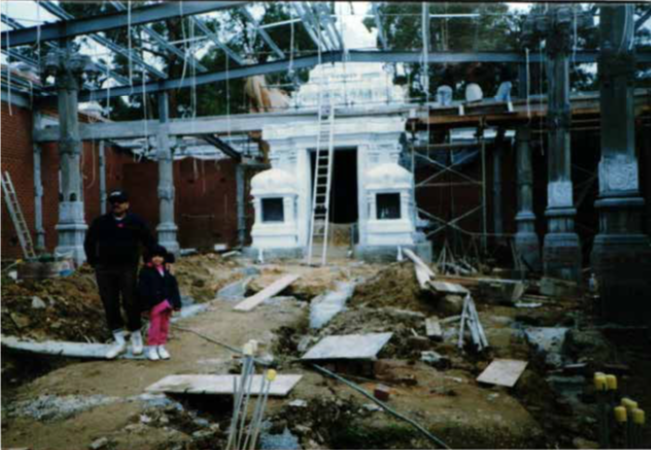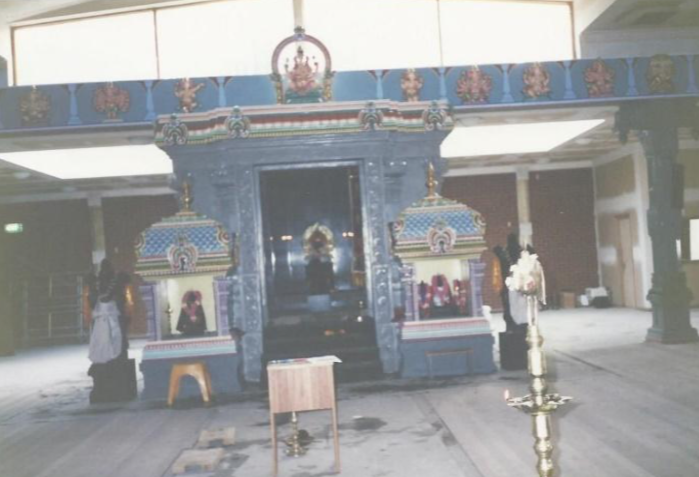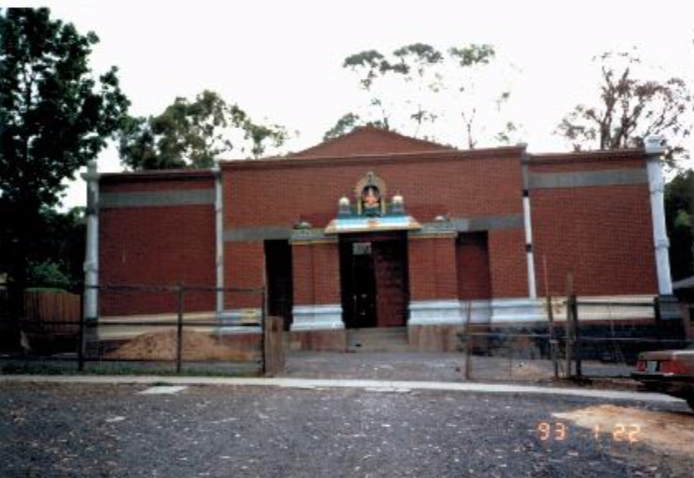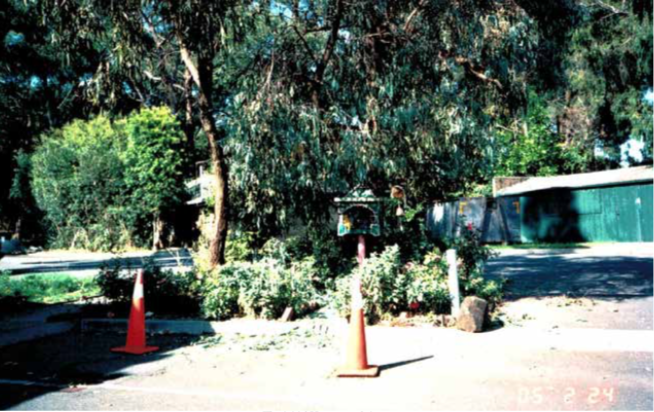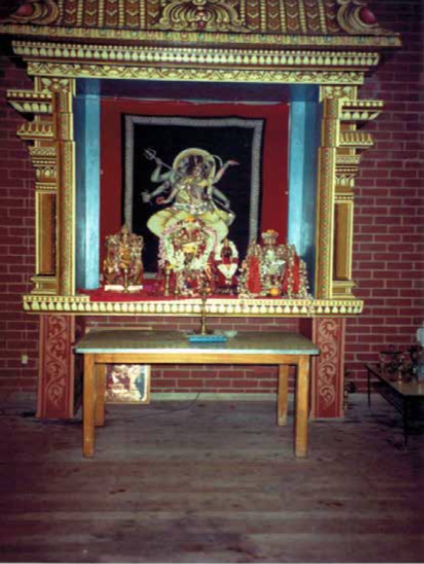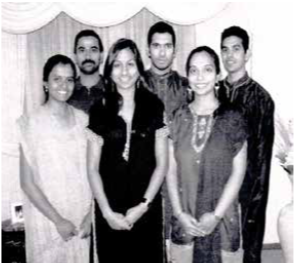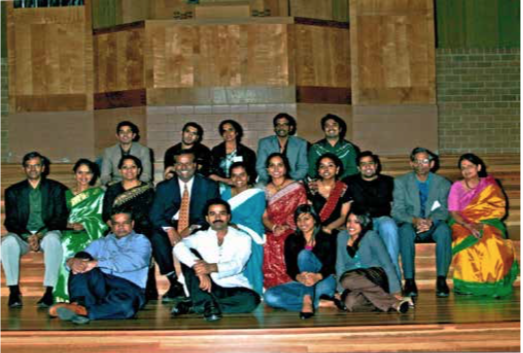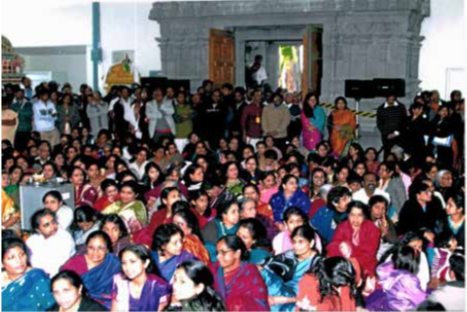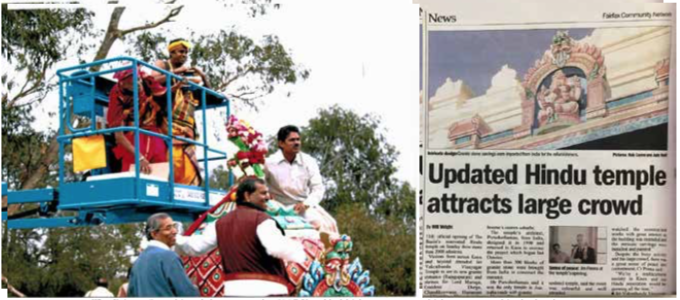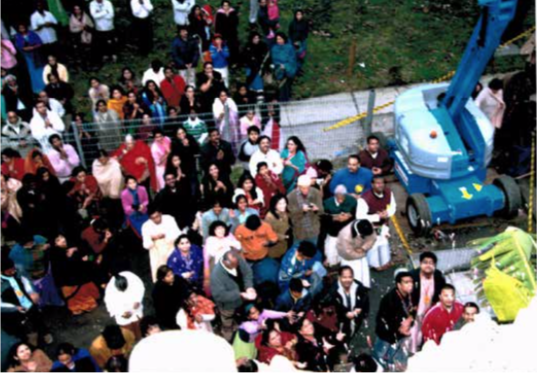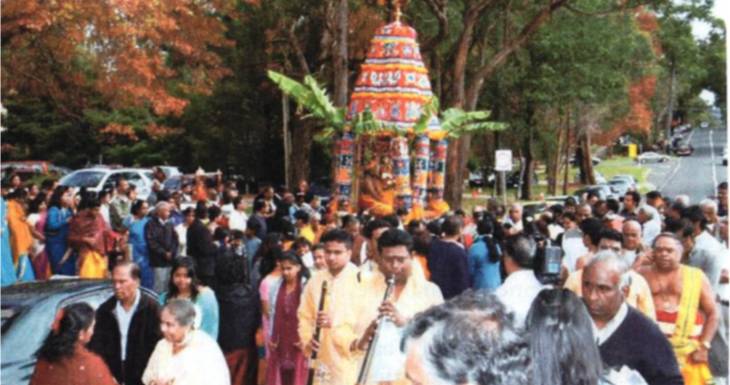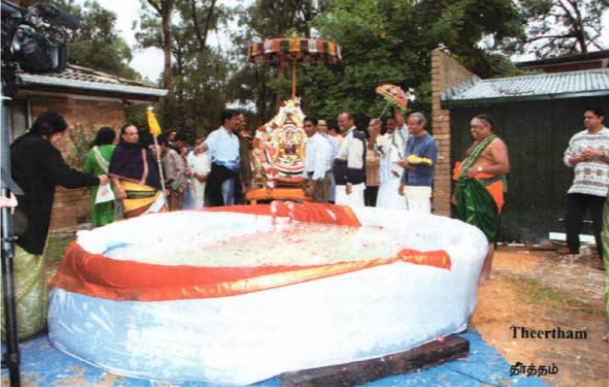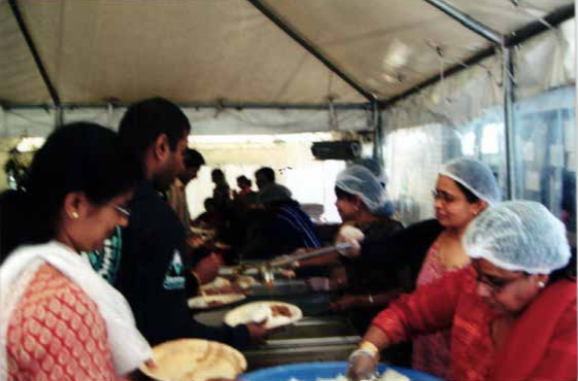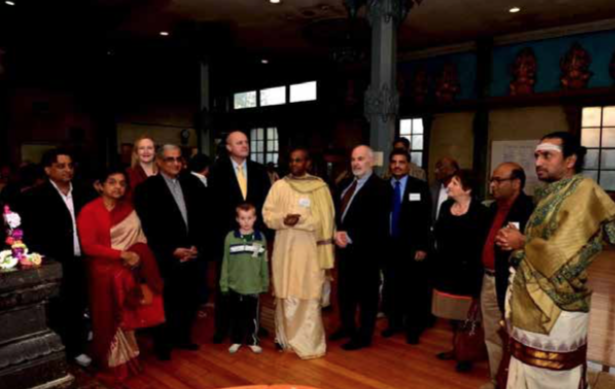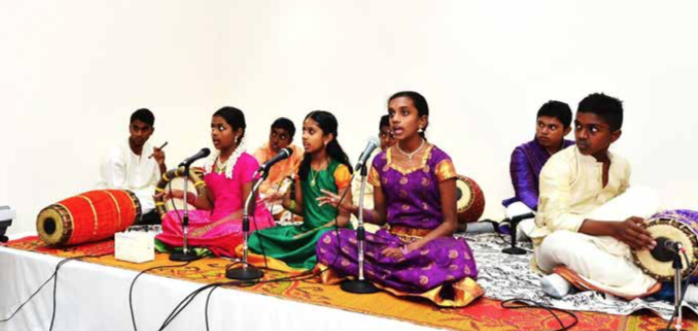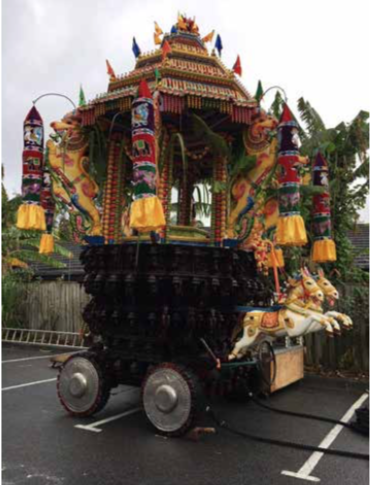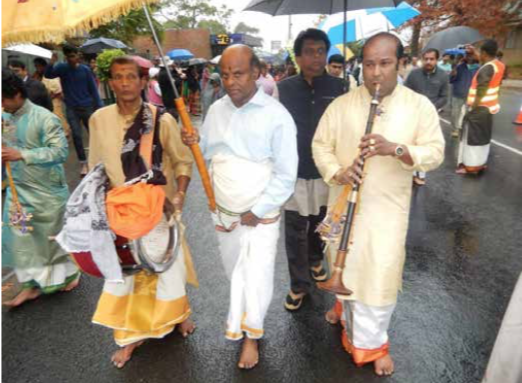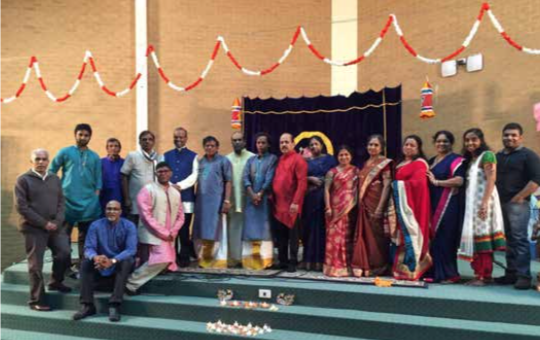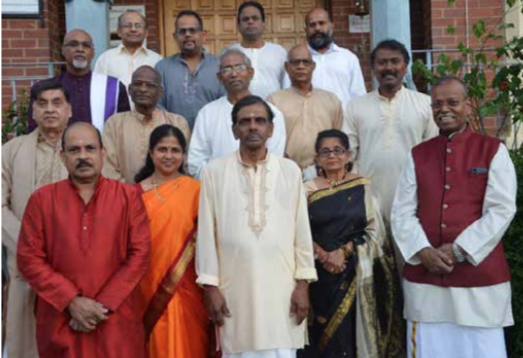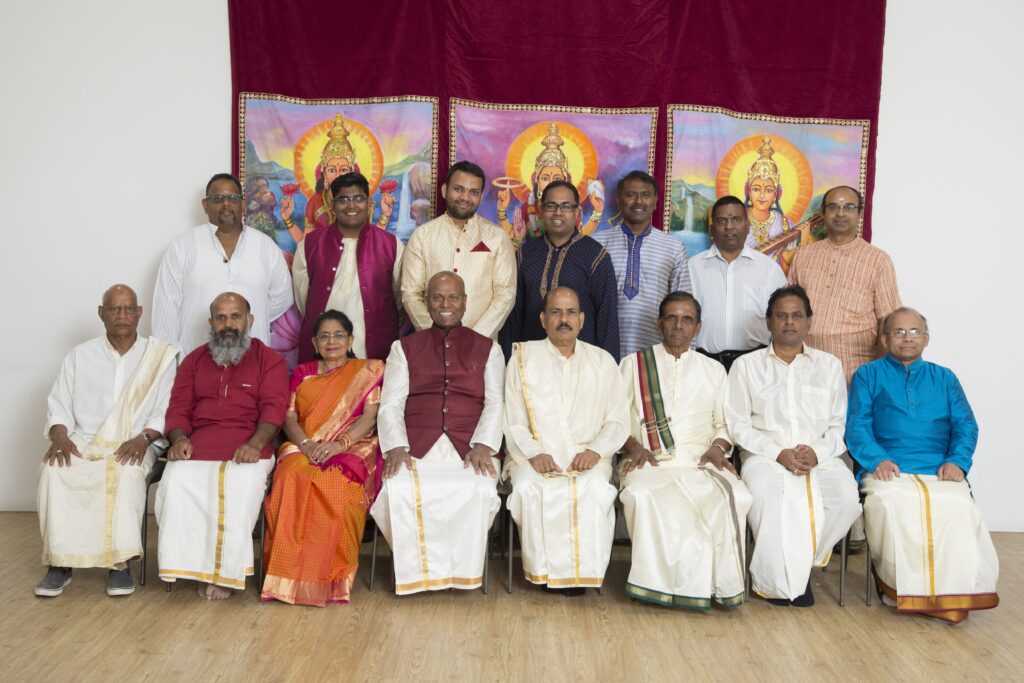The journey of Sri Vakratunda Vinayagar coming to Melbourne and making it His home is an interesting one.
1980s: How it all began
In August 1989, a ‘breakaway’ group from the Hindu Society of Victoria, decided to build a Vinayagar temple.
Amongst this group, a core team of people set up the ‘Pro Tem’ Management Committee and along with other likeminded individuals, began the gigantic task of building the first Vinayagar temple – Sri Vakratunda Vinayagar Temple – in Victoria.
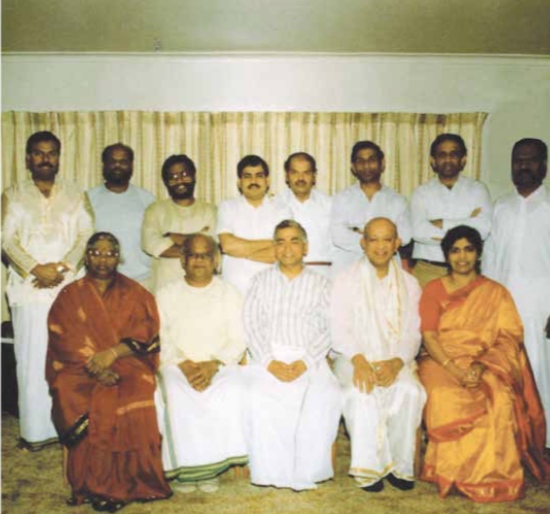
Standing left to right: Mr Shanmugaratnam K Pillai (Treasurer), Mr Sivagnanam K Pillai, Dr J Maheswaran, Mr K Thanabalasingam, Mr M Maheswaran, Mr K Thuraisingam, Mr K Balendra, Mr V Canagalingam
Seated left to right: Mrs P Somasundram, Mr S Somasundram, Dr K Shanmuganathan (Vice President), Dr S Selvendra, Mrs M Selvendra
Absent: Mr Nirmalan K Pillai (President), Dr G R Rajendra, Mr P Senthooran (Secretary), Mr A Dhanabalan, Mr M Kamaeswaran, Mr K Somasundaram, Mr T Sritharan, Mr V Thuraisingam
A trip to India – Twists and Turns
It had already been decided that a Vinayagar Vigraham and the necessary implements required for conducting poojas were to be purchased to set up the first Vinayagar temple in Victoria. Coincidentally, the Treasurer at the time, Mr Shan Pillai, his wife Parameswary and his mother-in-law Mrs A. Subramaniam, were going to India on a pilgrimage and offered to obtain the said items during their trip. They set out on their pilgrimage in late September 1989.
On arrival in Chennai, they placed an order with a promised delivery time of 25 October 1989. Special instructions were given to the Sthapathi that he had to prepare two Panchaloga Vigrahams, which would both be taken to Kanchi Swamigal in Kanchi Mutt to select one Vigraham.
Upon returning to Chennai from their pilgrimage, the Pillai’s discovered that the statues had not been completed and only the implements had been molded.
1989: A solution presents itself
Mr and Mrs Pillai visited the family of Sri Gnanasekara Kurrukkal and were introduced to their friend, Suresh who suggested that they all should visit Jagadguru Sri Sankaracharya Swamigal at Kancheepuram to explain their predicament and seek his guidance. It was more for their own peace of mind that they decided to make this trip.The entourage arrived in Kancheepuram on 3 November 1989 and met with Sri Jeyandra Saraswathi Swamigal. They explained their predicament to the Swamigal and to their amazement he ordered his assistant to request the Kancheepuram Stapathi to bring the Vinayagar statue that he had just completed. Swamigal blessed the granite statue and provided a letter stating that the statue was for consecration in Australia. This was a great help in taking the statue out of India.
1989: Another Vinayagar statue is ready
Upon returning to Chennai, Mr and Mrs Pillai were surprised to learn that the two Panchaloga statues that had been initially ordered, had arrived. The next day at 4am, the two statues were taken to Kancheepuram so that the most appropriate statue for the Temple in Melbourne could be selected. There, Sri Chandrasegara Saraswathi Swamigal of Kanchi Mutt selected one of the Panchaloga Vinayagar statues after much thought and that is now our single-faced Utsava Moorthy.
On their return journey, as the Pillai’s were going via Singapore, the two statues were kept in Singapore’s Sri Senpaga Vinayagar Temple. It was during this time that the ‘eye- opening’ ceremony for both the statues was performed by the famous Visvanatha Kurukkal and a local Stapathi, attracting some local publicity.
1989: Sri Vakratunda Vinayagar arrives in Melbourne
Two wooden boxes were made to bring the granite Vinayagar and the Panchaloga Vinayagar from Singapore to Melbourne. When the deities arrived in November 1989, they were housed at 386 Porter Street, Templestowe. The house had recently been acquired by Mr Nirmalan Pillai and his family, and a Ganapathy Homam had just been conducted as part of the housewarming.
One of the ‘Pro Tem’ Management Committee members, Mr Sabapathy Somasundaram carried out the daily early morning rituals of Abhishegams and prayers for the deities during this time. The Moola Moorthy (granite statue) remained in the house until the Vinayagar temple was built.
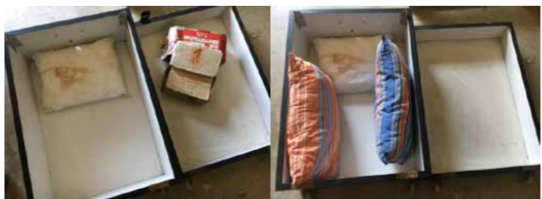
1990s: The birth of the Melbourne Vinayagar Hindu Sangam (MVHS)
1 January 1990, is an important date in the history of the Temple. This was the first ever gathering of all devotees to celebrate the New Year at Camberwell School Hall. More than 700 devotees attended this event where the very first Sangabhishegam to the Utsava Moorthy (Panchaloga Vinayagar) was performed.
At this function, a lottery was drawn amongst all those who had promised to become a Life Member (payment of $5,000) to select the person who becomes a Trustee of the Temple, Mr J Maheswaran was selected. Following this event the work of raising funds began earnestly by members, young and old.
The application for the registration of the Melbourne Vinayagar Hindu Sangam (MVHS) was lodged by Mr Sivagnanam on 7 March 1990. The final registration came through on 29 May 1990 – the day the Sangam was born with a goal of building a temple dedicated to Lord Vinayagar.
‘Pro Tem’ Pooja Committee Established
A ‘Pro Tem’ Pooja Committee was established to schedule and organise poojas for each year. A newsletter, ‘Saiva Neri’, was distributed with information on Temple events and poojas. Since the inception of the Sangam and until the first consecration, three different priests performed poojas and conducted festivals. They include Sri Gnanasegara Kurukkal, Sri Vijayan Sarma and Sri Arumuga Iyer. Amongst the priests at the time, Gnanasegara Kurukkal was the longest serving. He was always willing to help for the betterment of the Temple by being very frugal in his approach.
Members of the Sangam contributed in various ways to serve Sri Vakrathunda Vinayagar. The ‘Pro Tem’ Committee members and their wives were instrumental in looking after all the pooja requirements of the Temple. For instance, Mr Varatharajalingam travelled far to buy the flowers from the farm and then delivered it to 255 Porter Street, Templestowe, where the priest and other well-wishers gathered to work on the preparation for the event. Mrs P Somasundaram ensured that all the various matters were looked after in a timely and auspicious way. Be it a Chathurthi, Tamil New Year or any other festival.
Every time the deity was taken to the hall, the hall was first swept and then mopped – no matter the size – and then the deity was brought in. This aspect of the cleaning was generally done by Mrs P Senthuran, Mrs Parameswary Pillai, Mrs Rani Thuraisingam and other well-wishers. The deity would be carried by Mr Thanabalasingam, or Mr Kumarakuruparan together with Mr Canagalingam in his van. Mrs A Maheswaran, Mrs P Shanmuganathan and Mrs S Balendran would take turns to cook the food and bring it to the hall for Prasadam.
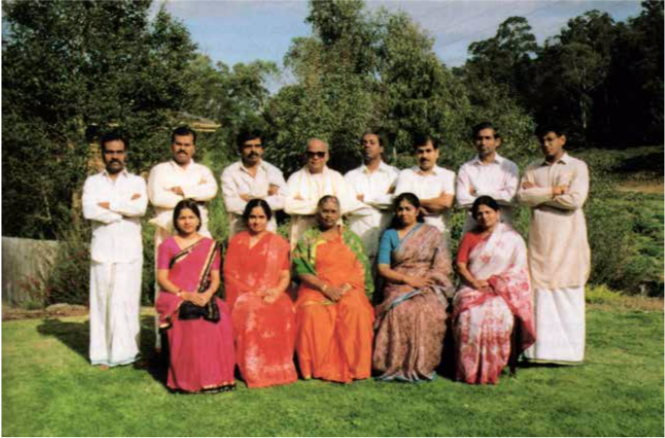
Seated L-R: Mrs S Parameswary, Mrs S Rohini, Mrs P Somasundram, Mrs T Rohini, Mrs T Selvarany
Standing L-R: Mr V Canagalingam, Mr K Shanmugaratnam Pillai, Mr T Sivanathan, Mr S Somasundram, Mr K Varatharajalingam, Mr K Thanabalasingam, Mr K Thuraisingam, Mr S Kumarakuruparan
Fundraising to build the first Vinayagar Temple in Victoria
A Temple building fund had been immediately set up after the formation of the Sangam. Five pioneers, Mr Nirmalan Pillai, Dr S Selvendra, Dr R Rajendra, Mr V Canagalingam and Mr S Somasundaram who later became the Trustees of the Sangam, each pledged $20,000. The Trustees were asked to pay their money immediately for the Temple to be able to pay for the deposit for the land. Life membership of the Sangam was set at $5,000 and ordinary membership at $1,000, both of which were one-off payments with no further annual subscriptions. In practice, most members could pay in installments.
More than $300,000 had already been pledged even before the Management Committee began to look for a suitable site for the Temple. Some members took personal loans of $10,000 each and gave that to the Temple. These loans were repaid by the Temple over time. As the Sangam had not been formally incorporated at the time of the purchase of the property, it had to be bought in the name of the 6 Trustees, (the five above and Mr J Maheswaran, the selected Trustee). In addition, Mr Nirmalan Pillai had to mortgage his house (386 Porter Street, Templestowe) to the bank before they would lend the money. This mortgage was subsequently redeemed in 1995 when the Sangam was able to borrow money in its own right.
20 April 1990: Building a home for Sri Vakratunda Vinayagar
On 20 April 1990, the Management Committee successfully purchased a plot of land in The Basin.
The site had formerly housed the disused St. Mary’s Anglican Church.A Building Committee was set up under the leadership of Mr M Maheswaran and this Committee was directed to prepare the necessary drawings, plans and specifications to apply for a planning permit to the City of Knox and take full charge of building the Temple.
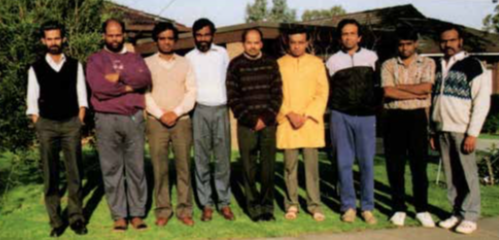
L – R: Mr A Wignarajah (Mechanical Engineer), Mr K Sivagnanam (Secretary), Mr K Kanakeswaran (Architect and Town Planner), Mr Y Suthan (Construction Manager), Mr M Maheswaran (Chairman, Building Committee), Mr R Devapalasundaram (Structural Certifier), Mr K Balendra (Member), Mr T Shanmugananthakumar (Structural Engineer), Mr V Canagalingam (Sri Vakratunda Vinayagar Temple Trustee)
Absent: Mr J Purushothaman (Sthapathi), Mr P Senthooran (Civil Engineer), Mr M Loganathan (Electrical Engineer), Mr N Jegaskanda (Asst. Construction Manager), Mr P Thananjeyan (Asst. Construction Manager)
1991: Laying the foundation for the Sri Vakratunda Vinayagar Temple
The foundation stones for the Temple were laid in November 1991 during a ceremony attended by a large crowd. The building permit was finally approved by the Council in December 1991.
1992: Building works in full swing
In February 1992, an Indian Temple architect or Sthapahi, Mr. J.Purushothaman, together with five artists from Mahabalipuram in Southern India, arrived in Melbourne to commence the building works.
While work was beginning in the Temple, a group of devotees, Mrs P Somasundaram, Mr Shan Pillai, Mr V Canagalingam, Mrs S Thuraisingam, Mrs R Sivanathan and Mr V Thuraisingam got together and purchased the house behind the Temple property (2 Conyers Street) on 21 February 1992. This house was then later sold at cost (with no profit) to the Sangam on 1 July 1994 when the Sangam could take the loan in its own right. This property currently houses the Chief Priest.
1992: The first Hindu temple established in Victoria
The consecration ceremony took place on 11 October 1992 with Somaskantha Kurukkal as the presiding Kurukkal. Thousands of devotees came to see the first Hindu temple consecration in Victoria.
It was a momentous affair as all the traditional ceremonies associated with the Consecration were complete, including the ‘Ennai Sathurathu’ (oiling the deities) etc. This was followed by 41 days of Mandalabhishegam. A souvenir magazine was also printed and distributed to all who attended this historic occasion.
1993 onwards: Continued fundraising activities
Raffle of Land
One of the big fundraising activities that the Sangam undertook in 1993 was to raffle a piece of land. In this the Sangam managed to get a net profit of $97,000. Mr Thanabalasingam was instrumental in making the application to the Raffle Board to conduct such a different raffle. The tickets were priced at $100 each and members were able to sell over 1,473 tickets at that time, grossing an income of $147,000.
Mr T Sivanathan and Mr S Somasundaram were critical in ensuring the success of this raffle. They were able to convince many of their relatives to purchase the tickets and make this fundraising effort a great success.
Vegetarian dinners were an annual event that was always well attended by many in the community. All the Committee Members contributed to the success of these events. In addition, the Friday ‘Dosa nights’ were also a source of income before the Kitchen was built. This was largely spearheaded by Mr and Mrs Sriharan and his group of well-wishers. Members have been providing their assistance in the annual Salvation Army appeal since the beginning of the Sangam. This effort was begun under the leadership of Dr N Shanmuganathan and in the last few years by Mr N Balasubramaniam.
As another fundraising event, members took on contracts for the Temple to do a full wedding – from decorating the Manavarai to cooking the food for the wedding. This was the time when Mr Varatharajalingam and Mr K Thuraisingam made a full garland Manavarai with the help of many of the ladies. All the proceeds from this went towards the building fund of the Temple. Dr Chandrabanu from Chandrabhanu Bharatalaya Academy, with the help of Ambika, organised a fundraising event, which included participation from Mr Balasri.
Expansion of Temple grounds
In 1995, the house adjacent to the Temple, 1290 Mountain Highway, was purchased to allow the Manager/Caretaker of the Temple to stay. This helped Mr Sivasamy who took on the role of Manager and caretaker of the Temple. He continued in this role for over 13 years and was a key member for the success of this Temple over those years.
Fundraising concerts and approval to build the Temple Kitchen
In 1996, a music concert by Shoba Shekar and Jayshree Ramachandran raised about $3,000 for the Temple building. The plans for the construction of the Temple kitchen was approved in 1997, after two years of planning, and the kitchen was built soon after.
Overcoming obstacles
In 1999, the Temple was impacted by a fire in the front part of the hall which was promptly brought under control. A Mahashanti was performed for this mishap.
The period from 2000 to 2004 is an unfortunate period in the Temple’s history. The Sangam was embroiled in a court case with some members of the Sangam which was eventually resolved by a court mandated settlement.
2004-2008: The years of rebuilding
This was a rebuilding period as the community had to be brought back after the court case of 2002-2004, which had a devastating impact on the morale of the devotees. In 2004, the Panchamuga Vinayagar was brought and a special consecration ceremony was held for Him.
The house behind the Temple kitchen, 4 Conyers Street, was purchased on 5 December 2005. In the years 2004 to 2009, Ramachandran was one of the key individuals who ensured that both the Temple and kitchen were functioning according to plan.
As part of fundraising and to encourage youth participation, the first Youth Committee was set up. They organised a talent quest, Kshipra, for members of the public on 13 May 2006 at Robert Blackwood Hall. This was a resounding success and the Committee raised over $8,400.
This was the period when the Temple went from paper based receipt books to computerised receipts.
Preparations for the Kumbhabhishegam
A Kumbabhishegam was well overdue, and the Temple needed significant repairs. The community slowly came back together to support the renovations and the building of the three-story Rajagopuram in granite.
In addidtion, the Moolasthanam glass panels were replaced and new ceiling boards incorporated. A Kodisthambam was also made. Several new shrines for Siva, Siva Durga and Murugan were built. Several new deities were also incorporated as niche deities, such as Nagathambiran. Hanuman who was in wooden shed on the tree next to the Temple, was brought in as a niche deity. The Vasantha Mandapam was extended to include Murugan, Valli and Devayani. New decorations were also completed along the wall of 16 Vinayagars and Astha Luxmis. All this work would not have been possible without the hard work and dedication of the members of the Building Committee, which was headed by Mr Kanakeswaran and supported by Mr VCS Raghavan.
2007: Punarvathana Maha Kumbhabhishegam
The Punarvathana Maha Kumbhabhishegam was held on 17 June 2007.
2008: First Mahotsavam
The First Annual Mahotsavam was held between 18 April and 28 April 2008 under the leadership of Gowrieswara Kurukkal. This was a grand festival and the Sri Vakrathunda Vinayagar Temple was the first temple in Victoria to hold such a festival.
It was with a great deal of difficulty that Mr Thanabalasingam was able to get the Council’s permission to take the Thaer (Chariot) out on the street. Today, this is part of the Council’s cultural calendar. This is an amazing achievement. Sri Vakrathunda Vinayagar Temple is also the first Temple, and continues to be the only temple, that takes the Thaer (Chariot) out in the streets of Melbourne.
2009-2012: Opening of Melbourne Vinayagar Cultural Hall and other community activities
Regular Annathanams were organised for occasions like the Puratasi Sani. The Temple was able to secure grants from the Government to build a multi-purpose hall next to the kitchen. In total, the Temple was able to secure $250,000 worth of grants. On 14 April 2012, the Melbourne Vinayagar Cultural Hall was completed and opened by Hon David Hodges, the Minister for Ports, Major Projects and Manufacturing.
In 2010, a musical program (Isaai Payanam) with Indian playback singers were organised by Mr Yogan Kandasamy in aid of the Temple building.
All the properties bought for the Temple were consolidated into one title.
The Balasthabanam for the Nagathambiran and Hanuman was performed to allow a roof over their shrines.
2013 – 2015: Arrival of the new Thaer (Chariot) and building of the Thaer shed
A new Thaer was purchased from Sri Lanka and assembled in Melbourne, and the Vellottam (initiation) was on 27 April 2013. The Thaer shed was completed and high-speed exhaust system was installed in the Temple to remove the soot from the burning of the oil lamps etc. The rear car park and the associated landscaping was completed.
Once again, the Temple was embroiled in a court case with the ex-president of the Sangam, which was settled out of court eventually.
2015-2017: Growing and celebrating 25 years
This period saw the Sangam amend its constitution for only the second time in its history. The Sangam organised a Natheswara Katchery by musicians from India and local musicians in 2016. It was during this period that the Temple became totally debt free.
The Temple continues to organise a number of activities to cater to the needs of the community. This includes organising poojas, Annathanams on special occasions and marking major festivals in the Hindu calendar in a grand and festive way.
No history of the Temple is complete without giving due recognition to the following individuals who have been toiling for the last 10 years.
N Balasubramaniam who has missed all the major functions in the Temple only because he has had to manage the car park. Also, he was instrumental in working with Council to remove the power lines to allow the Thaer to navigate smoothly around Conyers Street.
Ds. Manogaran for carrying out all the various maintenance work whenever it happens without regard to the time of the day. Importantly not to forget that he has been the ‘Parthasarathi’ of the Thaer.
B Jeeva for being the ‘handyman’ of the Temple – from fixing the lights for Deepavali to solving the problem of the slippery tiles in the Canteen.
K Thurasingam for working tirelessly not only with Nithiyanantham Kurukkal but also with other Kurukkal since inception, to do all the decorations for all the major functions.
S. Meera for consistently helping with the annual calendar and helping with the many functions that the Temple has organised.
G Moganaraju for his tireless support in organising many functions. J Rasaratnam for being the consistent volunteer helper in the Temple.
Vasanthi Mohan, Anietha Mohan, and Hari Mano for their dedicated work in sorting, ironing, pricing and selling the old Amman sarees at each major festival. Raj and Rani Nagarajan for ably managing the Temple canteen.
The “garland making” volunteers, the Canteen volunteers, the monthly Temple cleaning volunteers just to name a few of the ‘unseen pillars’ of the Sangam.
Today
Today, Sri Vakrathunda Vinayagar remains firmly in the hearts of devotees and a part of their lives. During major festivals, thousands and thousands of devotees gather to receive the blessings of Sri Vakrathunda Vinayagar. Many more have come forward to help the Temple.
What started out as a dream – to build the first Vinayagar Temple – has now become a reality thanks to the various members of the community who have contributed in one way or another. As more people come to hear of Him, His story and His miracles, Sri Vakrathunda Vinayagar continues show Himself to His devotees in many ways.

